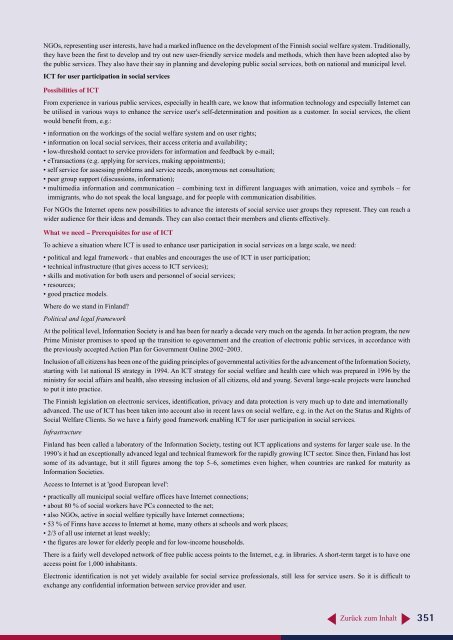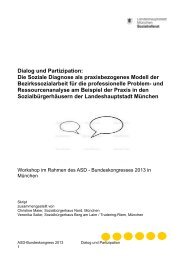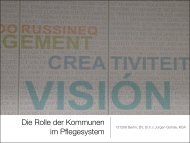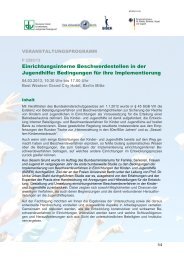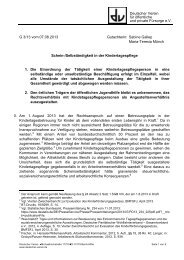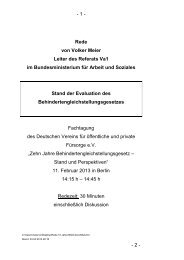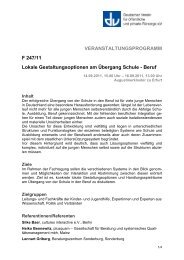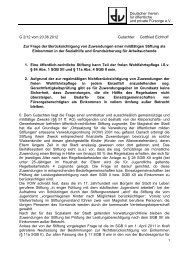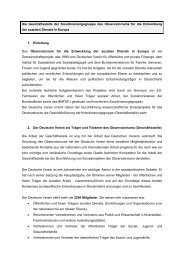Workshop 1.6 - Deutscher Verein für öffentliche und private Fürsorge
Workshop 1.6 - Deutscher Verein für öffentliche und private Fürsorge
Workshop 1.6 - Deutscher Verein für öffentliche und private Fürsorge
Sie wollen auch ein ePaper? Erhöhen Sie die Reichweite Ihrer Titel.
YUMPU macht aus Druck-PDFs automatisch weboptimierte ePaper, die Google liebt.
NGOs, representing user interests, have had a marked influence on the development of the Finnish social welfare system. Traditionally,<br />
they have been the first to develop and try out new user-friendly service models and methods, which then have been adopted also by<br />
the public services. They also have their say in planning and developing public social services, both on national and municipal level.<br />
ICT for user participation in social services<br />
Possibilities of ICT<br />
From experience in various public services, especially in health care, we know that information technology and especially Internet can<br />
be utilised in various ways to enhance the service user's self-determination and position as a customer. In social services, the client<br />
would benefit from, e.g.:<br />
• information on the workings of the social welfare system and on user rights;<br />
• information on local social services, their access criteria and availability;<br />
• low-threshold contact to service providers for information and feedback by e-mail;<br />
• eTransactions (e.g. applying for services, making appointments);<br />
• self service for assessing problems and service needs, anonymous net consultation;<br />
• peer group support (discussions, information);<br />
• multimedia information and communication – combining text in different languages with animation, voice and symbols – for<br />
immigrants, who do not speak the local language, and for people with communication disabilities.<br />
For NGOs the Internet opens new possibilities to advance the interests of social service user groups they represent. They can reach a<br />
wider audience for their ideas and demands. They can also contact their members and clients effectively.<br />
What we need – Prerequisites for use of ICT<br />
To achieve a situation where ICT is used to enhance user participation in social services on a large scale, we need:<br />
• political and legal framework - that enables and encourages the use of ICT in user participation;<br />
• technical infrastructure (that gives access to ICT services);<br />
• skills and motivation for both users and personnel of social services;<br />
• resources;<br />
• good practice models.<br />
Where do we stand in Finland?<br />
Political and legal framework<br />
At the political level, Information Society is and has been for nearly a decade very much on the agenda. In her action program, the new<br />
Prime Minister promises to speed up the transition to egovernment and the creation of electronic public services, in accordance with<br />
the previously accepted Action Plan for Government Online 2002–2003.<br />
Inclusion of all citizens has been one of the guiding principles of governmental activities for the advancement of the Information Society,<br />
starting with 1st national IS strategy in 1994. An ICT strategy for social welfare and health care which was prepared in 1996 by the<br />
ministry for social affairs and health, also stressing inclusion of all citizens, old and young. Several large-scale projects were launched<br />
to put it into practice.<br />
The Finnish legislation on electronic services, identification, privacy and data protection is very much up to date and internationally<br />
advanced. The use of ICT has been taken into account also in recent laws on social welfare, e.g. in the Act on the Status and Rights of<br />
Social Welfare Clients. So we have a fairly good framework enabling ICT for user participation in social services.<br />
Infrastructure<br />
Finland has been called a laboratory of the Information Society, testing out ICT applications and systems for larger scale use. In the<br />
1990’s it had an exceptionally advanced legal and technical framework for the rapidly growing ICT sector. Since then, Finland has lost<br />
some of its advantage, but it still figures among the top 5–6, sometimes even higher, when countries are ranked for maturity as<br />
Information Societies.<br />
Access to Internet is at 'good European level':<br />
• practically all municipal social welfare offices have Internet connections;<br />
• about 80 % of social workers have PCs connected to the net;<br />
• also NGOs, active in social welfare typically have Internet connections;<br />
• 53 % of Finns have access to Internet at home, many others at schools and work places;<br />
• 2/3 of all use internet at least weekly;<br />
• the figures are lower for elderly people and for low-income households.<br />
There is a fairly well developed network of free public access points to the Internet, e.g. in libraries. A short-term target is to have one<br />
access point for 1,000 inhabitants.<br />
Electronic identification is not yet widely available for social service professionals, still less for service users. So it is difficult to<br />
exchange any confidential information between service provider and user.<br />
Zurück zum Inhalt<br />
351


